Once you have bathed, dried and brushed the dog, you need to return it to its housing and secure it there.
Return the Dog to the Designated Area
As with moving the dog to the bathing and brushing work areas, it is safest for the dog to walk rather than be carried back to its enclosure. Walking may also help preserve the appearance of the freshly brushed dog, rather than pressing it against your body.
Replace the dog’s collar, if it has one. Then, place a slip lead over the head of the dog to secure it before you take it off the grooming table. Depending on the size of the dog and the equipment available, either carefully lift the dog to the floor, lower the grooming table or let it walk down a ramp.
Remember, when lifting dogs, you must support both the chest and the rump. Hold the dog close to your body for balance and to help minimise the dog’s wriggling. For large dogs, use appropriate equipment or ask for assistance to lower them to the ground.
Once the dog is on the floor, walk it to its designated area. In most cases, this will be the same crate or cage in which it was housed before you started the bathing, drying and brushing process. Check the cage card and work instructions to confirm that you are housing the right dog in the right place.
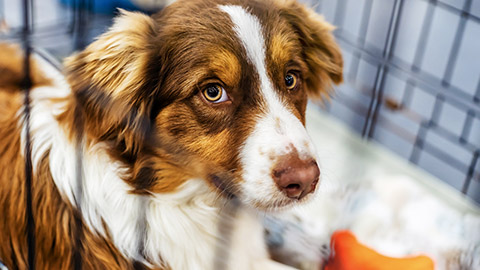
Let the dog enter the cage, using treats if necessary to encourage it, then remove the slip lead. Make sure to properly close the cage door and check that the dog can’t open it again. Ensure the dog has access to clean, fresh water and, if part of your workplace procedures, food that meets its dietary needs.

Follow your workplace procedures to record and report your observations of the dog’s behaviour and the condition of its coat and skin.
Record Your Observations
Depending on your workplace, the dog’s individual animal record may have a section for you to add notes about your observations of its behaviour and physical condition. Update these notes every time you work with the dog. For both behavioural and physical observations, it is important to track any changes over time.
For example, by recording your behavioural observations, you may see an improvement in the stress levels of an anxious dog over time or a sudden change in a previously calm and relaxed dog. These notes will help you and any other groomers determine the best handling techniques for that dog.
Recording your physical observations will identify the emergence or improvement of skin or other health conditions and highlight any problem areas that need special attention.
Some of the key things you should record include the following:
- Condition of the coat, including general cleanliness and presence of major matts or tangles
- Position and size of lumps, bumps, warts and moles to avoid nicks in the future and to report concerning changes to the veterinarian
- Condition and cleanliness of teeth, including whether any are sensitive, damaged, loose or missing
- Condition and cleanliness of ears, including any sensitivities
- Stiffness, lameness or sensitivities in any joints or limbs
- General behaviour, level of anxiety and aggression, any known triggers and effective handling techniques.
It can be helpful to take a photograph of any physical issues that you notice during the grooming session. Take a picture when you notice the issue, rather than at the end of the grooming session. The photographs can be included in the dog’s file for future reference and help reassure owners that the grooming tasks did not cause the issue.
It is easy to focus on recording issues. However, recording improvements or that there has been no change is also valuable information. It provides a baseline to compare future behaviour and physical condition too. Many clients will also appreciate hearing that you’ve thoroughly looked over their dog and didn’t find any issues.
Give Clear Information to the Client and Relevant Staff
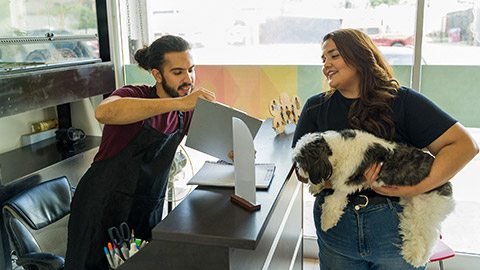
Share your observations with your supervisor, particularly if you observed some concerning behaviours or identified issues with the dog’s coat or skin condition. The more serious the issue, the quicker you should report it to your supervisor and other relevant staff.
For example, immediately notify your supervisor if you observe any of the following potentially life-threatening symptoms:
- Pale gums
- Changes in or difficulty breathing
- Sudden appearance of bruises or haematomas
- Difficulty standing.
If there is nothing concerning to report, it may be appropriate to just record your observations in the dog’s file and leave it at that.
However, where possible, you should always try to speak to the client when they pick up their dog. Sharing information with the client about their dog is a great way to build rapport with the client and increase the chance of them repeatedly using your services.
If a person cares enough about their dog to bring it in to be washed and brushed, they want to know that you care too. Talking specifically about the dog’s behaviour and its coat and skin condition, even if all is well, shows that you know their dog well and are taking the best possible care of it.
When giving information, be clear about what you want to share. Be honest and identify potential issues early. Make it clear to the client that you are not qualified to make a diagnosis, but that you have concerns and that you think the owner should keep an eye on the issue or that a veterinarian should examine the dog.
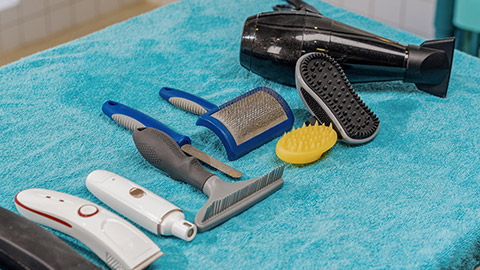
Once you have returned the dog to its housing, you need to clean and store the work areas and all tools, equipment and other items, ready for working with the next dog.
Cleaning Versus Disinfecting
It’s important to keep your salon hygienic to prevent the spread of germs, bacteria and pesticides, which could harm you and the dogs you groom.Reynold 2023
Hygiene is a critical part of your role as a dog groomer. Good workplace hygiene protects you, other staff, clients and the dogs you work with from infectious diseases. Cleaning and disinfecting are two key steps in maintaining good workplace hygiene.
Cleaning is a physical process that removes visible dirt and grime with the physical action of scrubbing or wiping. Cleaning may involve products, such as detergents, designed to break up substances, such as grease and oils, to help remove them from surfaces.
Disinfecting is a chemical process that kills bacteria, fungi and inactivates viruses on surfaces. Disinfecting typically uses chemicals, such as chlorines (bleaches) and alcohols, extremely high temperatures or ultraviolet (UV) radiation to destroy the pathogens (microbes that cause disease) (Diversey Australia 2020).
Cleaning and disinfecting are two separate steps. You must clean an object before you disinfect it. Cleaning on its own does not destroy pathogens and, if you disinfect without cleaning, pathogens can hide in or under the dirt.
Cleaning and Disinfecting Products
When choosing cleaning and disinfecting products make sure you choose pet-friendly and greywater-safe options and have a clear understanding of which products are for cleaning and which are for disinfecting and what their specific purposes are. For example, the product you use to disinfect surfaces may not be suitable for disinfecting combs and brushes.
Different cleaning and disinfecting products are available in concentrated or ready-to-use diluted forms. If dilution is required, follow the manufacturer’s dilution ratio and the dilution instructions provided previously in Topic 2, Subtopic 3 – Setting up the work area. Using concentrated products without proper dilution may result in chemical burns, respiratory distress or other health problems.
Always read the label and follow the manufacturer’s directions for use.
Cleaning Cloths and Other Tools
Depending on the size of the salon, it may be beneficial to have cleaning tools that are dedicated to different areas. For example, one set of brooms and mops for the bathing area, another set for the brushing area and another for the reception and waiting areas.
Another option is to have colour-coded cleaning cloths. Again, you might designate one colour for a particular work area, or for a particular task. For example, one colour of cloth for cleaning and a different colour for disinfecting. By using different tools in different areas or for different tasks, you minimise the risk of spreading disease throughout the entire salon.
Safe Cleaning Techniques
Many cleaning and disinfecting products can be harmful to work with if not handled appropriately. Recall that all potentially hazardous chemicals will have a corresponding safety data sheet (SDS).
Ensure you know where the SDSs are stored at your workplace and know how to look up a particular product.
It is safest to wear gloves when using any cleaning product, even if the SDS does not specify that you should. This is because regular use of cleaning and disinfecting products tends to dry out your skin and can cause contact dermatitis over time.

When using cleaning or disinfecting products in a spray form, it is usually safest to wear a face mask to prevent accidental inhalation. Inhaling products will be unpleasant at best but may cause asthma or other respiratory issues, especially with repeated exposure.
Safe Storage of Cleaning and Disinfecting Products
Always follow the storage instructions for a particular product as specified in the SDS. However, for most cleaning and disinfecting products, the following storage guidelines will be suitable:
- Store products in a clean designated space away from water, electrical and heat sources. Some products will react dangerously if there are significant changes to the temperature or humidity.
- Some products must be stored out of direct sunlight. If the SDS specifies this condition, store the product in a cupboard, rather than on a shelf.
- Store products in well-ventilated areas. A build-up of fumes can be potentially dangerous. Store products away from heating and air conditioning intake vents to help prevent any fumes from spreading to other parts of the grooming facility.
- Store products at a convenient and easily accessible height, such as no higher than eye level.
- Store containers of the same product together and do not overcrowd shelves. Ensure shelves have a lip to prevent products from accidentally slipping off the shelf.
- Ensure all stored products are clearly labelled with the name of the product, all relevant hazard warnings (as specified by the SDS) and a date of opening.
- Correctly rotate stock to ensure older products are placed towards the front of the shelf and therefore used before their expiry dates (Midlab 2019 and Jones n.d.).
Environmental Sustainability in Dog Grooming
Environmental sustainability is the practice of using and disposing of resources in a manner that ensures that the environmental conditions and resources are maintained for future use.
There are several ways in which you can use environmentally sustainable practices in a dog grooming facility, many of which are centred around cleaning.
Sustainable Resource Use
Resources are the things we use to complete our daily tasks. In dog grooming, common resources include equipment and products as well as utilities, such as electricity and water.
Conserving electricity and water is not only cost-effective but better for the environment. You can save electricity in several ways, including:
- choosing more efficient (higher star rating) equipment
- replace halogen or incandescent light bulbs with LED globes
- turn off equipment and appliances at the wall when not in use
- turn off the lights, heating or cooling in unused rooms
- wait for a full load before turning on the washing machine or dishwasher
- line dry rather than machine dry towels and cleaning clothes where possible
- install solar panels.
Watch
The following video, STAR RATINGS - The Energy Rating Label (0:53 min), explains how to interpret the energy rating label that is provided for many Australian appliances and equipment.
Bathing dogs requires a lot of water. However, there are still ways to reduce the amount of water you use in a dog grooming facility. Choosing water-efficient equipment, such as a dual tank hydrobath or a highly rated washing machine, can significantly improve your water usage.
Fixing dripping taps quickly and only using washing machines and dishwashers with full loads will also help reduce water use.
Sustainable Equipment and Product Choices
When choosing sustainable equipment, as well as its energy and water efficiency, consider the quality of the item and whether it can be easily repaired rather than thrown away and replaced frequently. Poor-quality items that cannot be repaired or recycled simply end up in overflowing landfills.
Sustainable products include those with recyclable or biodegradable packaging and are made with sustainably sourced ingredients and materials. Concentrated products or bulk-packaged products tend to be more sustainable because they often use less packaging than diluted products or those packaged in smaller quantities.
Products that are low in phosphorous and salts tend to be “greywater safe”. Products that are greywater safe can be used to water plants and gardens as a way of reducing water usage across an entire facility. Products typically state if they are greywater safe in the product information.
Greenwashing
Beware of terms such as “green”, “eco”, “natural” and “organic” on product labels. These terms imply that the product or the manufacturer is sustainable. However, none of these labels are regulated, so you can’t be sure that the product is actually sustainable unless you check with the manufacturer or with a regulatory body such as the Environmental Protection Agency (EPA) in your state or territory (Walden n.d.).
Using terms or packaging designs to encourage consumers to assume the environmentally sustainable nature of a product without any evidence that the company is sustainable, is known as greenwashing.
Sustainable Waste Disposal
Most products used in a dog grooming facility are safe to wash down the sink in their dilute form. For example, the shampoo residue can be washed down the drain after rinsing a dog.
However, if you need to dispose of a concentrated or hazardous substance you must always follow the manufacturer and SDS disposal instructions.
Greywater-safe shampoos and conditioners can be piped out of the bathing system, directly onto garden beds.
Cleaning Tools and Equipment
There are four main categories of items in a grooming salon that need to be properly cleaned and stored:
- Equipment
- Tools
- Laundry items
- Products.
Bathing and Grooming Equipment
Large equipment, such as baths, grooming tables and holding cages, must be cleaned and disinfected after every appointment to prevent the spread of pathogens and parasites, such as fleas or ticks.
- Start by removing and disposing of shed hair. You can use a vacuum for dry areas, such as the holding cages and grooming tables or a mop for wet areas in and around the baths.
- Wipe down all surfaces with an appropriate surface cleaner, making sure to remove any product residue, spilt food and any other soiling.
- Wipe down all surfaces again with a clean cloth and appropriate disinfectant.
- Thoroughly rinse baths after disinfecting and wipe dry with a chamois (Reynolds 2023).
Large equipment does not need to be stored. However, make sure everything is turned off, dried and loose items such as cords or hoses are tucked away to prevent trips and falls.
Brushing Tools
All brushes and combs that have come into contact with a dog should be washed and disinfected after every appointment. Check all equipment for damage before cleaning. Report any damaged items for repair, or dispose of them as appropriate.
Metal and other non-porous brushing tools can be placed in a container of liquid disinfectant solution, such as Barbicide or a vinegar solution, at the end of each appointment. Follow the manufacturer’s directions for the minimum length of time the items need to be soaked to fully disinfect, and how frequently you need to change the solution for it to be effective.
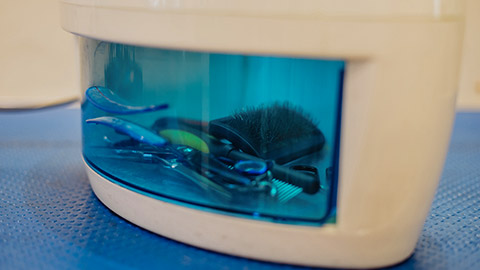
Soaking in liquid disinfectant is not suitable for porous tools, such as those containing wood or other natural materials. Instead, these tools can be disinfected in a UV sterilisation unit. Simply place the cleaned items inside the unit, close the door properly and turn the unit on. Follow the manufacturer’s instructions for how long the items need to be exposed to UV radiation to effectively kill all the pathogens. Many units come with a timer and will automatically switch off.
UV sterilisation does not use harmful chemicals, is suitable for all items and can destroy pathogens more effectively than chemical disinfectants. However, the units can be expensive to purchase.
Whether you use liquid disinfectant or UV sterilisation, soiled items should be cleaned first to remove any hair or other debris before being disinfected.
Only store items once they are clean, disinfected and completely dry. Store similar items together. For example, store all the slicker brushes with the same pin length in one place and all the wide tooth combs in another spot.
Store all brushing equipment out of reach of children and dogs! Some items can be very sharp and can cause injury if they are knocked over and fall or are improperly handled.
Laundry Items
For an additional level of hygiene, you may like to colour code the towels and use one colour to dry the head and body of the dogs and a different colour to dry their rear ends (Reynolds 2023).
Regardless of the type or number of towels you use, all towels, chamois and cleaning cloths should be washed after each appointment. Use a hot washing machine cycle (at least 60°C) and a pet-friendly, greywater safe detergent. Whether you line dry or use a tumble dryer, ensure all towels and cleaning cloths are completely dry before folding and putting them away.
Towels should be stored in designated a clean and dry location.
Dryers
Only store dryers if they are clean. Ensure the dryer is switched off and unplugged. Then, wipe any dust, dander or shed hair off the outside of all dryers. Empty and clean the air intake of HV dryers to prevent motor failure and fire. Neatly coil the electrical cable around the unit or hang it in neat loops on a hook. Always store blow dryers and any other electrical appliances in a clean and dry location.
Products
Check the stock levels for each product that you used that day. Compare the amounts against the minimum stock levels and order new products as required.
Check all product bottles and their nozzles for cracks. Where appropriate, decant any remaining product into clean and dry containers if the bottles show any damage. Make sure to clearly label the new container with the correct product name and any important directions for use.
Dispose of all remaining diluted or decanted products from your daily-use bottles and containers at the end of every day. Then, thoroughly wash, disinfect and dry all the containers. Pay particular attention to nozzles and pumps to remove any product buildup. Old product residue is a breeding ground for pathogens, such as the bacteriumPseudomonas aeruginosa, which is a common cause of post‐grooming furunculosis (PGF). PGF is the infection of hair follicles, which leads to the formation of painful abscesses and, in severe cases, necrosis (tissue death).
A research study into P. aeruginosa contamination of pet grooming products found that:
- Conditioning products were twice as likely to be contaminated than shampoo products.
- Containers larger than 1 L were twice as likely to be contaminated than containers less than 1 L in volume.
- Almost 40% of diluted products were contaminated, compared to approximately 7% of undiluted products (Perry et al. 2022).
You can read the full study, ‘Pseudomonas aeruginosa isolation from dog grooming products used by private owners or by professional pet grooming salons: prevalence and risk factors’, to learn more about the risk of PGF in dog grooming salons. Table 2 and Table 3 outline the association between different risk factors and specific grooming product ingredients and the incidence of contamination.
Ensure all empty containers are completely dry before storing them in a clean and dry location. It may be useful to store similar types or sizes of containers together.
Safety note
It is vital to empty, clean, disinfect and dry all bottles and containers at the end of every day to ensure all product residue is removed from all containers. This will help prevent products from becoming contaminated with bacteria and prevent the spread of infection between different dogs.
Storing Cleaned Items
Once all items have been thoroughly cleaned, disinfected if required, and dried, you must store them appropriately. Make sure you follow your workplace procedures and return all items to their designated places. Follow the manufacturer's instructions for cleaning and storing equipment such as blow dryers to ensure you do not void any warranties and prevent damage to the equipment.
Other Housekeeping Tasks
The following are some other common tasks required to maintain high workplace hygiene in a grooming salon.
Record Your Actions
Record the tasks that you have completed. Depending on your workplace, this may require initialling the work instructions or completing documentation, such as individual animal records or stock control forms.
Doggie Accidents
It is inevitable that you will need to clean up dog urine or faeces at some point. These accidents need to be dealt with immediately to prevent pathogens from spreading throughout the salon. Clean up the waste using paper towel and dispose of it in an outdoor bin. Mop the area, then disinfect it. You may like to “follow up with a pet-friendly deodoriser to eliminate any nasty odours” (Reynolds 2023).
Floors
Sweep, vacuum and mop the floors in the bathing and brushing work areas between every appointment if it is practical to do so. Frequently sweep or vacuum the corridors, reception and animal holding areas to prevent hair from spreading throughout the salon. Collect loose hair and dispose of it in the bin rather than just sweeping it into a corner for later. Runner brooms are ideal for grooming salons and are easy to disinfect.
All floors should be disinfected at least once a day. In most instances, this will be part of your last cleaning session for the day. Consider allocating a different mop to this task or to different areas of the salon to minimise cross-contamination between areas. Steam mops are great for a final mop because the temperature of the steam is hot enough to kill pathogens that the disinfecting mop may have missed.
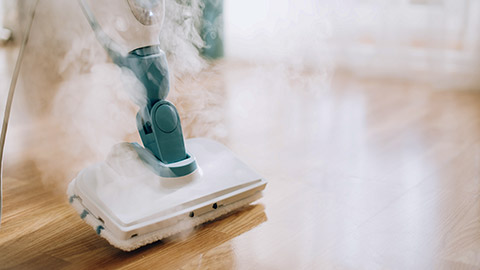
Personal hygiene is the process of keeping yourself clean. Good personal hygiene helps to protect you from infectious diseases and to reduce the likelihood of you spreading them to other people or to dogs.
Correct use of PPE is a key component of maintaining good personal hygiene. It helps to prevent you from coming into direct contact with disease-causing agents. However, even the best PPE in the world does not replace the need to wash your hands and change your clothes.
Washing Your Hands
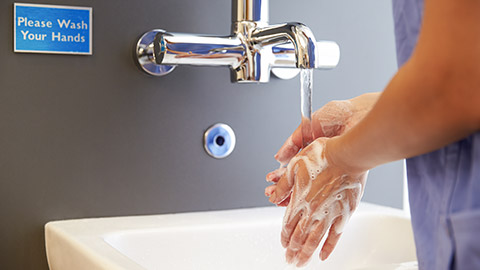
You may recall that there are four types of hand-washing routines:
- Routine handwash.
- Antiseptic handrub.
- Antiseptic handwash.
- Surgical antisepsis (Martin 2021).
In almost every case, a routine hand wash will be appropriate in a dog grooming role. You should use a routine hand wash before and after tasks such as:
- completing reception duties
- before and after preparing food or water for a dog
- bathing, drying and brushing a healthy dog
- using or diluting grooming or cleaning products
- eating your own food.
When conducting a routine handwash you should:
- Use soap and clean, running water.
- Move or remove rings and jewellery to wash underneath them.
- Rub your hands for at least 30 seconds to remove any particles and microorganisms.
- Dry your hands on a clean, dry towel or disposable paper towel.
- Ideally, use liquid soap and wash the dispenser before refilling (Martin 2021).
You should always wash your hands between working with different dogs, even if you wear gloves. This ensures that you don’t accidentally spread infections, such as ringworm, between individuals.
Changing Your Clothes
It can be a great idea to wear a grooming apron, smock, scrub top or sleeve covers to protect your clothes from getting wet, being splashed by grooming or cleaning products, or getting covered in dog hair. All of these contaminants could also spread disease between the different dogs you work with that day. So, protective clothing also makes it easier to ensure you are always wearing clean items before starting to work with a dog.
Make sure to remove any protective clothing at the end of a grooming task and replace it with clean items before you start to work with the next dog. Either dispose of the protective clothing items or add them to the items to be laundered at the end of the day, as appropriate.
Complete the following five (5) activities to check your knowledge and understanding of the key concepts of this topic. You may repeat this activity as often as you like. Use the arrows to move between the different activities.
Well done! You have now completed the theory for this module. You should now have the skills and knowledge required to bath, dry and brush domestic dogs from a range of different breeds.
The key concepts from this module include:
- the importance of confirming the specific work instructions for bathing, drying and brushing each dog
- how to prepare your work areas for bathing, drying and brushing dogs
- the steps involved in collecting the correct dog and washing it in a manner appropriate to its coat type
- the key techniques required to properly dry and brush a dog according to its coat type
- how to fully complete the work task, including reporting key observations, and cleaning and disinfecting all tooks and equipment.
Now that you completed the theory, you can start to prepare yourself for the Structured Workplace Learning and Assessment for this module.
- If you have not already done so, contact the workplaces where you would like to conduct your placement and discuss the requirements with your potential supervisor.
- Familiarise yourself with the Assessment Requirements for this Unit of Competency: ACMGRM201 Bath, dry and brush domestic dogs.
- Discuss any areas of this module that you find difficult with your trainer.
The following books and links may be useful to extend your knowledge or support your interest in bathing and brushing dogs.
- Notes From The Grooming Table 2nd Edition (2016) by Melissa Verplank. In particular:
- Chapter 1: Canine Anatomy
- Chapter 2: Tools and Equipment
- Chapter 6: Bathing
- Chapter 7: Drying
- Chapter 9: Brushing
- Dog Grooming Simplified: Straight to The Point (2014) by Jodi Murphy.
- Beyond Suds & Scents by Barbara Bird, which discusses the composition and uses of pet shampoos, conditioners and other grooming products.
- The World Organisation for Animal Health developed international standards for animal welfare. Section 7.1 Introduction to the Recommendations for Animal Welfare of the Terrestrial Animal Health Code provides general guidelines that are suitable for working with domestic dogs.
